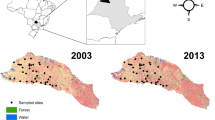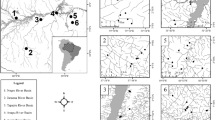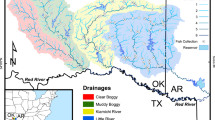Abstract
Context
The cumulative impact of broad scale environmental change includes altered land-cover and fragmentation. Both altered land-cover and fragmentation have a negative effect on species diversity, but the scale they act on may differ because land-cover alters environmental characteristics, whereas fragmentation alters movement among sites.
Objectives
We evaluated the scale specific effects of land-cover, fragmentation, and habitat size on alpha and beta diversity (total, turnover, and nestedness).
Methods
Stream fish communities were sampled across five urbanizing watersheds. Generalized mixed linear models were used to test how diversity (alpha and beta) is affected by land-cover, connectivity, and habitat size. Indices of land-cover were calculated from correspondence analyses on land-cover data, fragmentation was estimated with the dendritic connectivity index, and habitat size was calculated as the length of the stream segment (alpha diversity) or the length of the stream network (beta diversity).
Results
Alpha diversity was most strongly related to land-cover variables associated with urban development and agriculture (negative relationship with urbanization). Whereas, beta diversity was most strongly influenced by habitat size (positive relationship) and fragmentation (positive relationship). Turnover was positively correlated with fragmentation and habitat size, whereas species loss was negatively correlated with habitat size.
Conclusions
Land-cover has a larger effect on alpha diversity because it alters the environmental conditions at a site, whereas fragmentation has a larger effect on beta diversity because it affects the movement of individuals among sites. Assessing the cumulative impact of environmental change requires a multiscale approach that simultaneously considers alpha and beta diversity.






Similar content being viewed by others
References
Allan JD (2004) Landscapes and riverscapes: the influence of land use on stream ecosystems. Annu Rev Ecol Evol Syst 35:257–284
Altermatt F (2013) Diversity in riverine metacommunities: a network perspective. Aquat Ecol 47:365–377
Anderson GB, Freeman MC, Freeman BJ, Straight CA, Hagler MM, Peterson JT (2012) Dealing with uncertainty when assessing fish passage through culvert road crossings. Environ Manag 50:462–477
Andrén H (1994) Effects of habitat fragmentation on birds and mammals in landscapes with different proportions of suitable habitat: a review. Oikos 71:355–366
Angermeier PL, Winston MR (1998) Local vs. Regional influences on local diversity in stream fish communities of Virginia. Ecology 79:911–927
Banks-Leite C, Ewers RM, Metzger JP (2012) Unraveling the drivers of community dissimilarity and species extinction in fragmented landscapes. Ecology 93:2560–2569
Baselga A (2008) Determinants of species richness, endemism and turnover in European longhorn beetles. Ecography 31:263–271
Baselga A (2010) Partitioning the turnover and nestedness components of beta diversity. Glob Ecol Biogeogr 19:134–143
Baselga A, Jiménez-Valverde A, Niccolini G (2007) A multiple-site similarity measure independent of richness. Biol Lett 3:642–645
Baselga A, Orme CDL (2012) Betapart: an R package for the study of beta diversity. Methods Ecol Evol 3:808–812
Bates D, Mächler M, Bolker BM, Walker SC (2015) Fitting linear mixed-effects models using lme4. http://arxiv.org/abs/1406.5823v1
Booth DB, Jackson CR (1998) Urbanization of aquatic aystems: degradation thresholds, stormwater detection, and the limits of mitigation. J Am Water Resour Assoc 33:1077–1090
Brown BL, Swan CM (2010) Dendritic network structure constrains metacommunity properties in riverine ecosystems. J Anim Ecol 79:571–580
Butt S, Ramprasad P, Fenech A (2005) Changes in the landscape of southern Ontario, Canada, since 1750: impacts of European colonization. In: Fenech A, MacIver D, Auld H, Hansell R (eds) Integrated mapping assessment. Environment Canada, Toronto, pp 83–113
Carrara F, Rinaldo A, Giometto A, Altermatt F (2014) Complex interaction of dendritic connectivity and hierarchical patch size on biodiversity in river-like landscapes. Am Nat 183:13–25
Cooper AR, Infante DM, Wehrly KE, Wang L, Brenden TO (2015) Identfying indicators and quantifying large-scale effects of dams on fishes. Ecol Indic 61:646–657
Cote D, Kehler DG, Bourne C, Wiersma YF (2009) A new measure of longitudinal connectivity for stream networks. Landsc Ecol 24:101–113
Devictor V, Robert A (2009) Measuring community responses to large-scale disturbance in conservation biogeography. Divers Distrib 15:122–130
Erős T, Olden JD, Schick RS, Schmera D, Fortin M-J (2012) Characterizing connectivity relationships in freshwaters using patch-based graphs. Landsc Ecol 27:303–317
Etnier DA, Starnes WC (1993) The fishes of Tennessee. The University of Tennessee Press, Knoxville
Fagan WF (2002) Connectivity, fragmentation, and extinction risk in dendritic metapopulations. Ecology 83:3243–3249
Fahrig L (1997) Relative effects of habitat loss and fragmentation on population extinction. J Wildl Manag 61:603–610
Fahrig L (2003) Effects of habitat fragmentation on biodiversity. Annu Rev Ecol Evol Syst 34:487–515
Fahrig L (2013) Rethinking patch size and isolation effects: the habitat amount hypothesis. J Biogeogr 40:1649–1663
Falke JA, Gido KB (2006) Effects of reservoir connectivity on stream fish assemblages in the Great Plains. Can J Fish Aquat Sci 493:480–493
Fausch KD (2010) Preface: a renaissance in stream fish ecology. In: Gido KB, Jackson DA (eds) Community ecology of stream fishes: concepts, approaches, and techniques. American Fisheries Society, Bethesda, pp 199–206
Fausch KD, Torgersen CE, Baxter CV, Li HW (2002) Landscapes to riverscapes: bridging the gap between research and conservation of stream fishes. Bioscience 52:483–498
Furniss M, Love M, Firor S, Moynan K, Llanos A, Guntle J, Gubernick R (2006) FishXing. US Forest Service. San Dimas Technology and Development Center, San Dimas
Grant EHC (2011) Structural complexity, movement bias, and metapopulation extinction risk in dendritic ecological networks. J N Am Benthol Soc 30:252–258
Grant EH, Lowe WH, Fagan WF (2007) Living in the branches: population dynamics and ecological processes in dendritic networks. Ecol Lett 10:165–175
Hanski I (1999) Habitat connectivity, habitat continuity, and metapopulations in dynamic landscapes. Oikos 87:209–219
Henriques-Silva R, Lindo Z, Peres-Neto PR (2013) A community of metacommunities: exploring patterns in species distributions across large geographical areas. Ecology 94:627–639
Isaac JL, Vanderwal J, Johnson CN, Williams SE (2009) Resistance and resilience: quantifying relative extinction risk in a diverse assemblage of Australian tropical rainforest vertebrates. Divers Distrib 15:280–288
Jackson DA, Harvey HH (1989) Biogeographic associations in fish assemblages: local vs. regional processes. Ecology 70:1472–1484
Jackson DA, Peres-Neto PR, Olden JD (2001) What controls who is where in freshwater fish communities the roles of biotic, abiotic, and spatial factors. Can J Fish Aquat Sci 58:157–170
Johnson RK, Angeler DG (2014) Effects of agricultural land use on stream assemblages: taxon-specific responses of alpha and beta diversity. Ecol Indic 45:386–393
Labonne J, Ravigné V, Parisi B, Gaucherel C (2008) Linking dendritic network structures to population demogenetics: the downside of connectivity. Oikos 117:1479–1490
Leibold MA, Holyoak M, Mouquet N, Amarasekare P, Chase JM, Hoopes MF, Holt RD, Shurin JB, Law R, Tilman D, Loreau M, Gonzalez A (2004) The metacommunity concept: a framework for multi-scale community ecology. Ecol Lett 7:601–613
Mahlum S, Cote D, Wiersma YF, Kehler D, Clarke KD (2014a) Evaluating the barrier assessment technique derived from FishXing software and the upstream movement of Brook Trout through road culverts. Trans Am Fish Soc 143:39–48
Mahlum S, Kehler D, Cote D, Wiersma YF, Stanfield L (2014b) Assessing the biological relevance of aquatic connectivity to stream fish communities. Can J Fish Aquat Sci 1863:1852–1863
Mandrak NE (1995) Biogeographic patterns of fish species richness in Ontario lakes in relation to historical and environmental factors. Can J Fish Aquat Sci 52:1462–1474
Morrissey MB, de Kerckhove DT (2009) The maintenance of genetic variation due to asymmetric gene flow in dendritic metapopulations. Am Nat 174:875–889
Nakagawa S, Schielzeth H (2013) A general and simple method for obtaining R2 from generalized linear mixed-effects models. Methods Ecol Evol 4:133–142
Neff MR, Jackson DA (2012) Geology as a structuring mechanism of stream fish communities. Trans Am Fish Soc 141:962–974
Neff MR, Jackson DA (2013) Regional-scale patterns in community concordance: testing the roles of historical biogeography versus contemporary abiotic controls in determining stream community composition. Can J Fish Aquat Sci 70:1141–1150
Nislow KH, Hudy M, Letcher BH, Smith EP (2011) Variation in local abundance and species richness of stream fishes in relation to dispersal barriers: implications for management and conservation. Freshw Biol 56:2135–2144
Oksanen J, Blanchet FG, Kindt R, Legendre P, Minchin PR, O’Hara RB, Simpson GL, Solymos P, Stevens MHH, Wagner H (2015) Vegan: community ecology package. R package version 2.3-0
Ontario Ministry of Natural Resources (2002) Southern Ontario Land Resource Information System (SOLRIS). Ontario Ministry of Natural Resources, Peterborough
Padgham M, Webb JA (2010) Multiple structural modifications to dendritic ecological networks produce simple responses. Ecol Model 221:2537–2545
Page LM, Burr BM (1991) A field guide to freshwater fishes of North America north of Mexico. Houghton Mifflin Company, Boston
Pardini R, de Arruda Bueno A, Gardner TA, Prado PI, Metzger JP (2010) Beyond the fragmentation threshold hypothesis: regime shifts in biodiversity across fragmented landscapes. PLoS ONE 5(10):e13666. doi:10.1371/journal.pone.0013666
Pease AA, Taylor JM, Winemiller KO, King RS (2011) Multiscale environmental influences on fish assemblage structure in central Texas streams. Trans Am Fish Soc 140:1409–1427
Perkin JS, Gido KB (2012) Fragmentation alters stream fish community structure in dendritic ecological networks. Ecol Appl 22:2176–2187
Perkin JS, Gido KB, Costigan KH, Daniels MD, Johnson ER (2015) Fragmentation and drying ratchet down Great Plains stream fish diversity. Aquat Conserv 25:639–655
Pinheiro JC, Bates DC (2000) Mixed-effects models in S and S-PLUS. Springer, New York
Poos MS, Jackson DA (2012) Addressing the removal of rare species in multivariate bioassessments: the impact of methodological choices. Ecol Indic 18:82–90
Puric-Mladenovic D, Buck J, MacIntosh A (2011) Pre-settlement Vegetation Mapping for the Greater Toronto Area, including the Regions of Hamilton, Halton, Peel and York and the Credit Valley Watershed. Ontario Ministry of Natural Resources, Peterborough
R Core Team (2015) R: a language and environment for statistical computing. R Foundation for Statistical Computing, Vienna
Rolls RJ, Ellison T, Faggotter S, Roberts DT (2013) Consequences of connectivity alteration on riverine fish assemblages: potential opportunities to overcome constraints in applying conventional monitoring designs. Aquat Conserv 23:624–640
Scott WB, Crossman EJ (1973) Freshwater fishes of Canada. Bull Fish Res Board Can 184:1–96
Stanfield L (2010) Ontario stream assessment protocol. Version 8.0. Fisheries policy section. Ontario Ministry of Natural Resources, Peterborough
Stanfield LW, Kilgour BW (2013) How proximity of land use affects stream fish and habitat. River Res Appl 29:891–905
Strecker AL, Casselman JM, Fortin MJ, Jackson DA, Ridgway MS, Abrams PA, Shuter BJ (2011) A multi-scale comparison of trait linkages to environmental and spatial variables in fish communities across a large freshwater lake. Oecologia 166:819–831
Taniguchi Y, Rahel FJ, Novinger DC, Gerow KG (1998) Temperature mediation of competitive interactions among three fish species that replace each other along longitudinal stream gradients. Can J Fish Aquat Sci 55:1894–1901
Tuomisto H (2010) A diversity of beta diversities: straightening up a concept gone awry. Part 1. Defining beta diversity as a function of alpha and gamma diversity. Ecography 33:2–22
Ulrich W, Almeida-Neto M, Gotelli NJ (2009) A consumer’s guide to nestedness analysis. Oikos 118:3–17
Walsh CJ, Roy AH, Feminella JW, Cottingham PD, Peter MG, Morgan RP (2005) The urban stream syndrome: current knowledge and the search for a cure. J N Am Benthol Soc 24:706–723
Wenger SJ, Peterson JT, Freeman MC, Freeman BJ, Homans DD (2008) Stream fish occurrence in response to impervious cover, historic land use, and hydrogeomorphic factors. Can J Fish Aquat Sci 65:1250–1264
Whittaker RH (1960) Vegetation of the Siskiyou Mountains, Oregon and California. Ecol Monogr 30:279–338
Zuur AF, Ieno EN, Walker NJ, Saveliev AA, Smith GM (2009) Mixed effects models and extensions in ecology with R. Springer, New York
Acknowledgements
This study would not have been possible without the staff at the Toronto and Region Conservation Authority who conducted the majority of the fish sampling and all of the barrier assessments. Additional fish sampling data provided by the Ontario Ministry of Natural Resources and Forestry is appreciated greatly. All fish sampling was approved by and carried out under appropriate animal care and use guidelines. Funding for manuscript preparation was provided by the Canadian Water Network, the Toronto and Region Conservation Authority, and the Natural Sciences and Engineering Research Council of Canada.
Author information
Authors and Affiliations
Corresponding author
Electronic supplementary material
Below is the link to the electronic supplementary material.
Rights and permissions
About this article
Cite this article
Edge, C.B., Fortin, MJ., Jackson, D.A. et al. Habitat alteration and habitat fragmentation differentially affect beta diversity of stream fish communities. Landscape Ecol 32, 647–662 (2017). https://doi.org/10.1007/s10980-016-0472-9
Received:
Accepted:
Published:
Issue Date:
DOI: https://doi.org/10.1007/s10980-016-0472-9




